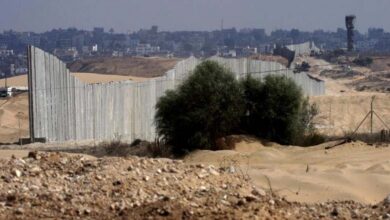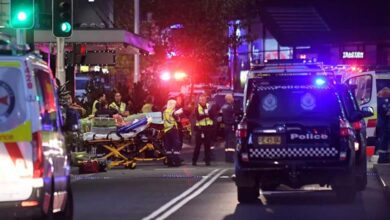The coexistence of opposites in Gaza: life pulsing among the dead

In Gaza, death is no longer an eternal end, but a neighbor who shares the details of daily life with the living among the graves—a scene that embodies the coexistence of opposites.
Overcrowding and the lack of shelter throughout the Gaza Strip have driven about thirty displaced families to live in tents inside a cemetery in Khan Younis, in the southern part of the Strip. The living and the dead now share the same space in search of refuge.
-
Ruling Gaza Until 2027: Details of the U.S. Draft Resolution at the UN Security Council
-
Unexploded ordnance: a silent terror haunts Gaza after the war
Thus, skeletal remains have become the neighbors of some Palestinians who could find no other haven from the war than the cemeteries themselves.
The Associated Press stated that tombstones have become seats and tables for families like that of Maysaa Brika, who has lived with her children in a cemetery in Khan Younis for five months. Around thirty families have sought shelter there.
Outside one of the tents, a blond-haired boy plays with sand slipping through his fingers during the day, while another peeks shyly from behind a fabric curtain.
-
Secret U.S. Report: Hundreds of Israeli Violations in Gaza Under Investigation
-
Safe Corridor… Details of a New US Offer to Hamas in Gaza
But the night tells a different story. “When the sun sets, the children are scared and refuse to go outside. I have four young ones. They’re afraid to go out because of the dogs at night—and the dead,” says Brika.
During the two years of war that erupted following Hamas’s attack on southern Israel on October 7, 2023, more than two million Palestinians have been displaced in the Gaza Strip.
After the ceasefire took effect on October 10, some returned to what remained of their homes, while others remained trapped in the few areas not controlled by Israeli forces.
-
Israeli raids on Gaza: the heaviest loss of life in a single night since the ceasefire
-
After the Truce… a Silent Enemy Threatens Gaza
Life pulsing among the dead
In its report, the Associated Press shed light on daily life in the Khan Younis cemetery and others, describing life that still beats among the dead: “a prayer rug hanging from a clothesline, a child pushing a water jug on a wheelchair between the graves, smoke rising from cooking fires.”
One of Brika’s closest “neighbors” is Ahmad Abu Said, who died in 1991 at the age of eighteen, according to the inscription on his tombstone, which begins with verses from the Quran.
Families feel uneasy living among the graves, yet they have no other choice. Brika explains that her family home in Khan Younis was completely destroyed and that the neighborhood is now under Israeli military control.
-
New Gaza between American Opportunity and Palestinian Fears
-
Harsh living and the specter of war: Gaza’s exhausted residents still suffering
Some of those living in the Khan Younis cemetery came from northern Gaza, far from the burial places of their relatives.
Mohammed Shamma says he has lived in the cemetery for three months. Standing on a broken tombstone and gazing toward the sun, he admits: “I am a grown man, but I’m still afraid of the graves at night, so I hide inside my tent.”
His wife, washing dishes in a small basin and saving every drop of water, adds that “the lack of money to find shelter elsewhere is one reason families remain among the graves.”
She continues: “Of course, life in the cemetery is full of fear, horror, and anxiety. We barely sleep, and we live under constant stress.”
-
Arab States Reject Israeli Plan to Divide Gaza
-
Vance Tackles Thorny Issues in Gaza: Hamas’s Arsenal and Reconstruction
Even the graves are not safe
Even among the dead, there is no safety. According to the United Nations and other observers, Israeli forces have bombed cemeteries during the war.
Israel accuses Hamas of using some cemeteries as hiding places, arguing that this strips them of their legal protection.












